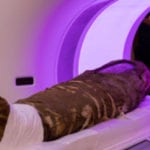 Miscellaneous
Miscellaneous  Miscellaneous
Miscellaneous  Gaming
Gaming 10 Funny Tutorials in Games
 History
History 10 Fascinating Little-Known Events in Mexican History
 Facts
Facts 10 Things You May Not Know about the Statue of Liberty
 Movies and TV
Movies and TV 10 Movie Adaptions That Brought Popular Songs to Life
 Health
Health 10 Miraculous Advances Toward Curing Incurable Diseases
 Miscellaneous
Miscellaneous 10 Undeniable Signs That People’s Views of Mushrooms Are Changing
 Animals
Animals 10 Strange Attempts to Smuggle Animals
 Travel
Travel 10 Natural Rock Formations That Will Make You Do a Double Take
 Movies and TV
Movies and TV 10 Actors Hidden in Your Favorite Movies
 Miscellaneous
Miscellaneous 10 Interesting Things Manufacturers Stopped Making and Why
 Gaming
Gaming 10 Funny Tutorials in Games
 History
History 10 Fascinating Little-Known Events in Mexican History
Who's Behind Listverse?

Jamie Frater
Head Editor
Jamie founded Listverse due to an insatiable desire to share fascinating, obscure, and bizarre facts. He has been a guest speaker on numerous national radio and television stations and is a five time published author.
More About Us Facts
Facts 10 Things You May Not Know about the Statue of Liberty
 Movies and TV
Movies and TV 10 Movie Adaptions That Brought Popular Songs to Life
 Health
Health 10 Miraculous Advances Toward Curing Incurable Diseases
 Miscellaneous
Miscellaneous 10 Undeniable Signs That People’s Views of Mushrooms Are Changing
 Animals
Animals 10 Strange Attempts to Smuggle Animals
 Travel
Travel 10 Natural Rock Formations That Will Make You Do a Double Take
 Movies and TV
Movies and TV 10 Actors Hidden in Your Favorite Movies
10 Incredible Scientific Facts About The Planet Uranus
Named after the Greek god of the sky, the planet Uranus was discovered by the famous astronomer William Herschel in 1781. Too dim for the ancient scientists to see with the naked eye, it was the first planet to be located using a telescope. As a result, Uranus was thought at first to be a star or comet by the legendary astronomer and his peers.
Eventually known as the seventh planet from the Sun, this enigmatic, beautiful, gassy, blue-green ice giant is so far away from its home star that one full orbit takes 84 Earth years to complete.
The gas and ice giants in our solar system are so far away from Earth that they are extremely hard to observe and study. The Voyager missions have been the sole source of much, if not all, of the real raw data we have on the outer planets. So these missions have been highly instrumental in aiding our current understanding of these planets.
10 A Planet With A Mind Of Its Own
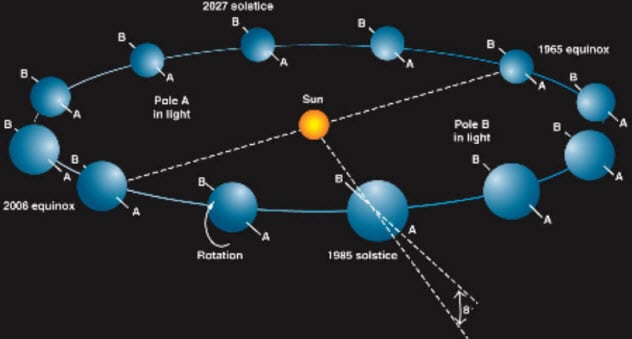
Like Venus, Uranus rotates from east to west, which is the exact opposite of the direction in which Earth and most of the other planets rotate. A day on Uranus is rather short, lasting only 17 Earth hours and 14 Earth minutes.
The rotational axis of the planet is skewed at an angle almost parallel to its orbital plane, causing Uranus to look as though it is rotating on its side like a marble rolling across the floor. A “normal” planet looks like a basketball spinning on a finger.[1]
Planetary scientists theorize that this rotational anomaly may have resulted from a gigantic collision between Uranus and another celestial body such as an asteroid. Due to this unorthodox rotation, the seasons on Uranus are each 21 Earth years long. This causes huge variances in the amount of sunlight that the planet receives at different times and in different regions throughout the long Uranian year.
9 The Ring System Of Uranus
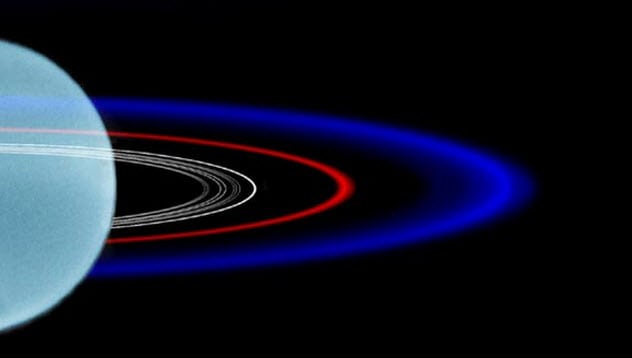
In January 1986, the space probe Voyager 2 came within 81,500 kilometers (50,600 mi) of the upper cloud banks of Uranus while transmitting to Earth huge amounts of data about the icy giant, including its magnetic field, interior, and atmosphere. This historic NASA mission also sent back thousands of digital photographs of the planet, its moons, and its rings.
Yes, that’s correct, its rings. Like all the giants in the solar system, Uranus has rings. Several scientific instruments on the probe concentrated on the ring system, unveiling fine details of the known ones and discovering two previously unknown rings for a total of 13.
The debris in the rings ranges from dust-size particles to solid objects as big as small boulders. There are two brightly colored outer rings, and 11 somewhat fainter inner ones. The inner rings of Uranus were first discovered in 1977, while the outer two were discovered by the Hubble Space Telescope between 2003 and 2005.[2]
Nine of the 13 rings were discovered accidentally in 1977 while scientists were observing a distant star that had passed behind the planet, revealing them as it did. The rings of Uranus actually exist as two distinct “ring sets” or “ring systems,” which is also rather unusual in our solar system.
8 The Weird And Wild Weather Of Uranus
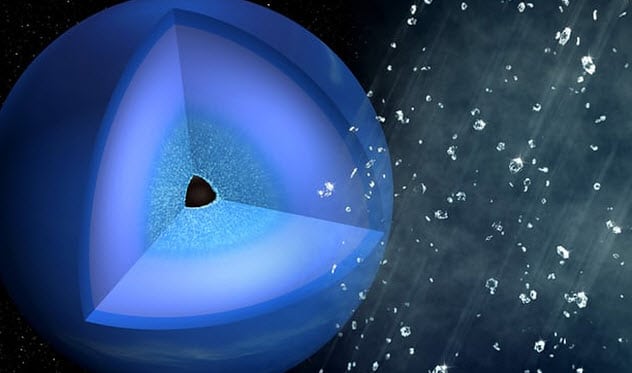
On planet Earth, we enjoy rain in the form of liquid water. Sometimes, it might rain strange red organisms or even fish. But for the most part, the rain on Earth is harmless.
On Titan, it rains methane. Venus has acid rain that evaporates before it reaches the ground. But on Uranus, it rains diamonds. Solid diamonds.
Using the brightest source of X-rays on the planet, scientists finally have what they consider to be solid proof of this long-held scientific claim. Published in Nature Astronomy in 2017, the work involved marrying a highly powered optical laser, the Linac Coherent Light Source (LCLS), with the X-ray free-electron laser at the SLAC National Accelerator Laboratory, which produces X-ray pulses lasting one million-billionth of a second!
This results in superfast and extremely precise auditing of processes all the way down to the atomic level. Using this setup, the scientists witnessed miniscule diamonds form as shock waves passed through a special plastic. This allowed a glimpse of processes that occur in the atmospheres of planets but on a much larger scale.
The plastic material, called polystyrene, consists of carbon and hydrogen (which are two elements that are abundant on Uranus), so inducing shock waves into the material was the main focus of the experiment. The theory involves methane, consisting of one carbon atom and four hydrogen atoms that reside in the atmosphere and create hydrocarbon chains that ultimately turn into diamonds when the right amount of heat and pressure are applied.
This happens more than 8,000 kilometers (5,000 mi) below the surface of the planet, where the diamonds leech out and eventually form diamond rain. Dominik Kraus, lead author of the Nature Astronomy article, said, “When I saw the results of this latest experiment, it was one of the best moments of my scientific career.” These tiny diamonds are known scientifically as nanodiamonds.[3]
Nanodiamond rain is thought to occur on Neptune as well.
7 Uranus Is The Coldest Place In The Solar System . . . Sometimes
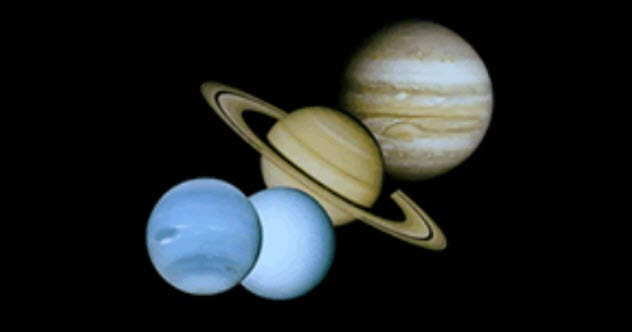
With a minimum atmospheric temperature of -224 degrees Celsius (-371.2 °F), Uranus stays an average distance of 2.9 billion kilometers (1.8 billion mi) away from the Sun and is at times the coldest place in the solar system.[4]
On the other hand, Neptune keeps an average distance of 4.5 billion kilometers (2.8 billion mi) from the Sun and so stays in heated contention for the coldest planet. Which planet do you think is the coldest—Neptune, with an average temperature of -214 degrees Celsius (-353.2 °F), or Uranus?
From a logical point of view, many would choose Neptune because it is the farthest planet from the Sun. But those people would be wrong. Uranus gives Neptune a run for its money in the bid to be the coldest body in the solar system.
Currently, there are two theories as to why Uranus is sometimes the coldest planet. First, Uranus appears to have been slammed onto its side by an earlier collision, which would cause heat from the planet’s core to escape into space. According to the second theory, Uranus’s lively atmosphere during its equinox could be spilling heat.[4]
6 Why Is Uranus Blue-Green?
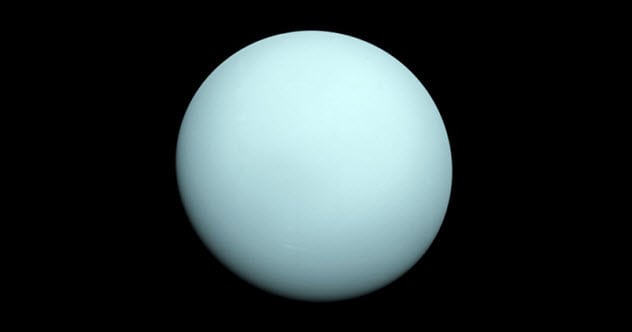
As one of only two ice giants in the outer reaches of the solar system (Neptune being the other), Uranus has an atmosphere very similar to that of its gassy brother Jupiter—mainly hydrogen and helium with some methane and trace amounts of ammonia and water. It is the methane gas in the atmosphere that gives the planet its beautiful blue-green hues.[5]
By absorbing the red portion of sunlight, methane causes a blue-green coloration to set in on the icy behemoth. Most of the mass of Uranus—up to 80 percent, if not more—is held firmly together within a fluid core that consists mainly of frozen elements and compounds such as ammonia, water ice, and methane.
5 Uranus Might Be Hiding Two Moons
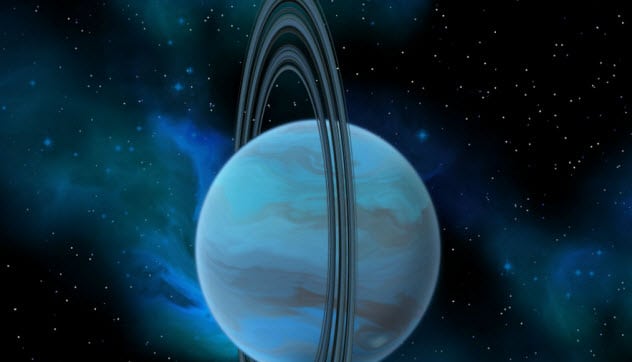
When Voyager 2 did a flyby of Uranus in 1986, it discovered 10 new moons for a new grand total of 27. However, if the planetary scientists at the University of Idaho are right, the probe missed a couple of moons during its historic mission.
When reviewing the Voyager data, planetary scientists Rob Chancia and Matthew Hedman discovered that two rings around the planet, named Alpha and Beta, possessed rippling. Similar wavy patterns had been caused before by the gravity of two passing moons, Ophelia and Cordelia, as well as a couple dozen spheres and orbs zooming around the icy giant.
It is thought that the rings around Uranus were formed by the gravity of these small bodies zipping around it and forcing particles of space dust and other debris into the thin rings we see today. The discovery of these latest patterns of rippling strongly suggests the existence of two unknown moons.[6]
If these moons do exist, Chancia believes that they are very small, probably 4.0–13.7 kilometers (2.5–8.5 mi) in diameter. As a result, Voyager’s camera either could not see them or they showed up as background noise in the images.
Mark Showalter of SETI fame said, “The new discoveries demonstrate that Uranus has a youthful and dynamic system of rings and moons.” In other words, it is assured that Uranus will continue to amaze us.
4 The Mysterious Magnetic Field Of Uranus

This is weird. The planet’s magnetic poles are not even close to aligning with its geographic poles. Uranus’s magnetic field is askew by 59 degrees from the planet’s spin axis and is shifted in such a way that it does not go through the center of the planet.
For comparison, the magnetic field of Earth is tilted by only 11 degrees and is similar to a bar magnet, which has a North Pole and a South Pole and is referred to as a dipole field. Uranus’s magnetic field is much more complex. It has a dipole component and another part with four magnetic poles.
Considering all these different magnetic poles and the major tilting of the planet, it’s no wonder that the magnetic field varies greatly at different locations. For example, in the southern hemisphere, Uranus’s magnetic field has only one-third the strength of the field on Earth. However, in the northern hemisphere, Uranus’s magnetic field is almost four times stronger than Earth’s field.[7]
Scientists believe that a large, salty body of water on Uranus is providing the impetus for the planet’s magnetic field. They used to think that the 59-degree tilt of Uranus’s magnetic field and the 98-degree tilt of its spin axis would supply the planet with a powerful magnetosphere. But they were wrong.
Uranus’s magnetosphere is fairly normal and no different than that of other planets. Scientists are still trying to figure out why. They did discover that Uranus experiences auroras similar to the northern and southern lights here on Earth.
3 NASA Probe Voyager 2 And Uranus
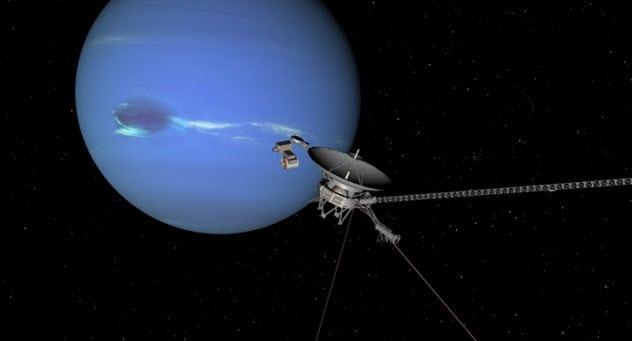
Launched on August 20, 1977, the NASA space probe Voyager 2 became the first and so far the only NASA spacecraft to perform a flyby of Uranus, sending back the first close-up images of the great blue sphere.[8]
During its lengthy mission, Voyager 2 has successfully completed a flyby of all four so-called “gas giants,” starting with Jupiter in July 1979, then Saturn in August 1981, Uranus in January 1986, and Neptune in August 1989.
Voyager 1 left our solar system to venture into interstellar space in 2012. Voyager 2 is still in the heliosheath, the outer region of the Sun’s bubble (aka heliosphere). Eventually, Voyager 2 will fly into interstellar space as well.
2 Uranus Stinks

A recent study suggests that the clouds in the upper atmosphere of Uranus are chiefly composed of hydrogen sulfide, which is the chemical compound responsible for the bad smell of rotten eggs. For a long time, scientists have been interested in the composition of these clouds, especially wondering if they are chiefly made of hydrogen sulfide ice or ammonia ice like those of Saturn and Jupiter.
As Uranus is so distant, highly detailed observations of the ice giant are difficult at best. In addition, with only one flyby of the planet by Voyager 2 way back in January 1986, answers to these questions are hard to come by.
Scientists used the Near-Infrared Integral Field Spectrometer in Hawaii to study sunlight reflecting from the atmosphere just above the tops of the clouds on Uranus. They detected the signature for hydrogen sulfide. Leigh Fletcher, coauthor of the study, said:
Only a tiny amount remains above the clouds as a saturated vapor, and this is why it is so challenging to capture the signatures of ammonia and hydrogen sulfide above cloud decks of Uranus. The superior capabilities of Gemini finally gave us that lucky break.
Scientists surmise that the clouds of Uranus and Neptune are very much alike. They probably differ from those of Saturn and Jupiter due to coalescing so much further from the Sun than the two gas giants. Patrick Irwin, lead author of the study, stated, “If an unfortunate human were ever to descend through Uranus’s clouds, they would be met with very unpleasant and odoriferous conditions.”
He added, “Suffocation and exposure in the -200 degrees Celsius [-328 °F] atmosphere, made of mostly hydrogen, helium, and methane, would take its toll long before the smell.”[9]
1 Uranus Is Tilted Sideways From Multiple Impacts
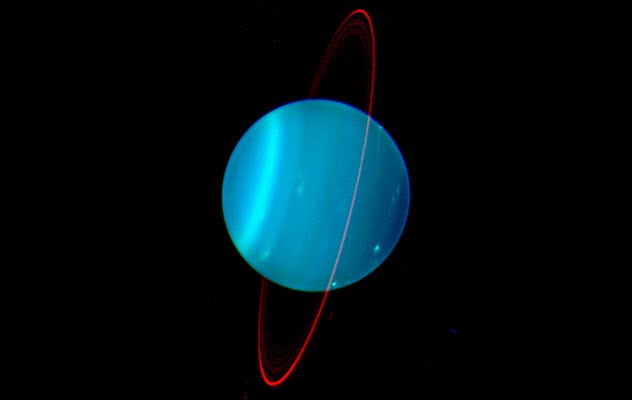
According to most, Uranus is an “oddball” in the solar system and is often called “the tilted planet.” Researchers say that recent findings are shedding new light on the ancient history of the icy giant, including the formation and evolution of all the giant planets in our solar system.
In 2011, then–study leader Alessandro Morbidelli said, “The standard planet formation theory assumes that Uranus, Neptune, and the cores of Jupiter and Saturn formed by accreting only small objects in the protoplanetary disk. They should have suffered no giant collisions.”
He continued, “The fact that Uranus was hit at least twice suggests that significant impacts were typical in the formation of giant planets, so the standard theory has to be revised.”[10]
Uranus really is an odd one. Its spinning axis is out of whack by an absurd 98 degrees. The giant ball of icy gas is basically rolling on its side. No other planet in the solar system even comes close to being 98 degrees off-kilter.
For example, Earth is off by a substantial 23 degrees, while giant Jupiter is tilted by just 3 degrees. For quite a while, scientists have believed that one large impact caused Uranus’s massive tilt. But after running a series of complex computer simulations, they may have discovered a more suitable explanation.
They began the simulation by using a single-impact model in the very early days of the solar system. This showed that the severely skewed equatorial plane would be translated to the moons, making them just as tilted. So far, they were right, but there was a surprise coming.
With a single-collision model, the moons would orbit in the opposite direction of what they do today. Not good. So the researchers tweaked the program parameters to simulate an impact with two bodies. They discovered that a minimum of two smaller collisions would explain the motions of the moons as they are today. Obviously, more research will be needed to verify these results.
I live in northwestern Pennsylvania in the United States of America and in “one of the Original 13,” as I like to say, where I grew up with a fascination for collectibles like baseball cards, coins, stamps, and old bottles, just to name a few. Always a self-starter, I’ve taught myself many different things and have ended up with a large variety of skills and hobbies in both the old and new and have recently started putting them to use on the Internet. I have been writing in several capacities for decades.
Read more amazing facts about Uranus on 10 Plans Scientist Have Already Proposed For Colonies In Space and 10 Types Of Precipitation That Are Out Of This World.





